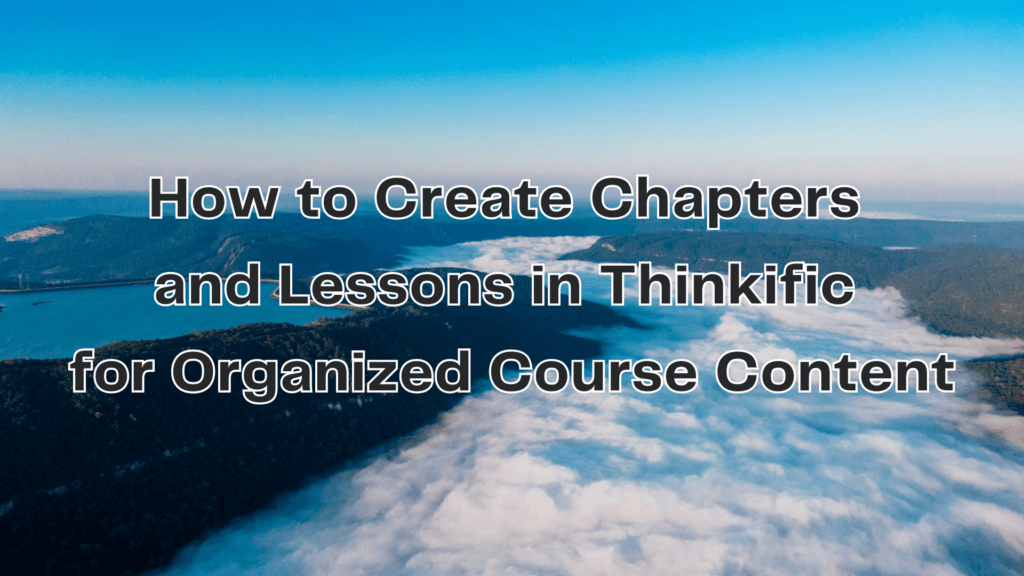As an e-learning platform, Thinkific provides users various features to create, market, and sell online courses. One of the most important aspects of creating an effective online course is having a well-organized and structured curriculum.
In this article, we’ll explore how to use Thinkific’s chapter and lesson creation tools to build organized course content that engages your learners and enhances their learning experience. Whether you’re a seasoned online instructor or just starting with Thinkific, this guide will provide the tools to create structured courses that deliver results. Let’s get started!
Understanding Chapters and Lessons in Thinkific
Thinkific’s course creation tools allow you to create courses with structured content, making it easier for your learners to understand and engage with the material. Chapters and lessons are two key building blocks of this structured approach.
What are Chapters in Thinkific?
Chapters are the main sections of your course, similar to the chapters in a book. Each chapter typically covers a broad topic or theme; you can include multiple lessons within each chapter.
What are Lessons in Thinkific?
Conversely, lessons are individual units of content that make up the chapters in your course. Each lesson should be focused on a specific topic or learning objective and should be designed to build upon the knowledge gained in previous lessons.
The purpose of chapters and lessons in Thinkific is to provide learners with a clear and organized roadmap for their learning journey. By breaking down your course content into manageable chunks, you can help learners understand and retain the material more easily.
Chapters vs. Lessons
One key difference between chapters and lessons in Thinkific is the level of granularity. Chapters provide a higher level of organization and structure, while lessons offer a more detailed and focused approach to learning.
As a course creator, balancing these two elements ensures learners stay engaged and motivated throughout the course.
> > Click Here to Start Your Free Trial < <
Creating Chapters in Thinkific
To create structured course content in Thinkific, you’ll need to start by creating chapters. Here’s a step-by-step guide to getting you started:
- Go to Manage Learning Products > Courses: Log into your Thinkific account and access the Manage Learning Products area. Then, select the Courses tab underneath.
- Click on a specific course: Find the course you want to add chapters to and click on it to open the Course Overview. Once you’re in the Course Overview, navigate to the Course Curriculum area of the Course Builder.
- Click Add Chapter: In the Course Curriculum area, click the Add Chapter button on the left side of the page.
- Name the Chapter title field as desired: Name the chapter title field with a title that reflects the content covered in the chapter.
- Click Save: After you’ve added the title, click Save to create the chapter.
Once you’ve created your chapters, organizing them is important to provide a logical and easy-to-follow flow for learners. A good practice is to group similar content in a single chapter and arrange the chapters to follow a natural learning progression.
Another important consideration when creating chapters in Thinkific is to use clear and descriptive titles. Doing so will help learners understand the content covered in each chapter and make navigating the course easier. Consider also considering numbering your chapters logically to help learners follow along.
Adding Lessons to Chapters
Once you’ve created your chapters in Thinkific, it’s time to add lessons to them to provide learners with more detailed and focused content. Here’s a step-by-step guide on how to add lessons to your chapters:
- Go to Manage Learning Products > Courses: Start by logging into your Thinkific account and navigating to the Manage Learning Products area. Then, click on the Courses tab underneath.
- Click on a specific course, leading you to the Course Builder: Once you’ve found the course you want to add lessons to, click on it to open it.
- Click Add Lesson: In the Course Curriculum area, click on the Add Lesson button on the page’s left side.
- Select the desired Lesson Type: Choose the type of lesson you want to add from the options in Thinkific. There are different types of lessons, which we will cover shortly.
- Name the Lesson Title as desired: Name the lesson title field with a title that reflects the content covered in the lesson.
- Add your content and select your desired settings for the lesson: Depending on the type of lesson you’ve chosen, you’ll need to add the relevant content and customize the settings.
- Click Save: After you’ve added the content and customized the settings, click Save to create the lesson.
Types of Lessons Available in Thinkific
Thinkific provides a range of lesson types you can choose from when creating your course content. Here are the different types of lessons available:
Presentation
This type of lesson includes videos, multimedia, text, PDFs, audio files, narrated presentations, webinars, and live streams. You can also use tools like ADOBE Captivate, Articulate Storyline, and HTML5 to create engaging presentations.
Practice
This type of lesson includes activities like downloadable files, discussion lessons, and assignments. These lessons help learners practice and apply what they’ve learned in the course.
Assessment
This type of lesson includes quizzes, surveys, Brillium exams, and alternative quiz types. These lessons help learners evaluate their understanding of the course content and provide feedback on their progress.
When adding lessons to your chapters in Thinkific, it’s important to organize them in a way that provides a logical and easy-to-follow flow for learners. You can group similar lessons in a single chapter and arrange the chapters in a way that follows a natural learning progression.
Additionally, it’s important to use clear and descriptive titles for your lessons so that learners can quickly and easily understand the content covered in each lesson.
By following these best practices, you can create engaging and effective course content in Thinkific that helps learners achieve their learning objectives.
> > Click Here to Start Your Free Trial < <
Conclusion
In conclusion, creating organized and structured courses in Thinkific is key to providing effective learning experiences for your students. By understanding the difference between chapters and lessons, you can create a course that is easy to navigate and follow.
With the step-by-step guides and best practices provided, you can confidently create chapters and lessons within your Thinkific course and organize them for better course flow. Remember to use the different lesson types available and to name and number your chapters logically. With these tips and tricks, you can create a course to engage and educate your students.
In addition to the information provided in this article, Thinkific offers a wealth of resources and tools to help you create and optimize your online course. Visit the Thinkific Help Center for more detailed information on course creation. Consider joining Thinkific community groups on social media to connect with other course creators and get feedback on your course!



